3.2 Basic Concepts of Antimicrobial Therapy
Basic Concepts Related to Antimicrobial Therapy
Before we learn about antimicrobial medications used to treat infections, we must first understand the basics of microbiology. Let’s begin with a review of bacteria. Bacteria are found in nearly every habitat on earth, including within and on humans. Most bacteria are harmless or considered helpful, but some are pathogens. A pathogen is defined as an organism causing disease to its host. Pathogens, when overgrown, can cause significant health problems or even death.
Specific bacteria may be identified when a client has an infection by using a culture and sensitivity test or a gram stain test. An antibiotic is selected by the prescribing provider based on the type of bacteria and the mechanism of action of the medication. Antimicrobials are classified as broad-spectrum or narrow-spectrum, based on the variety of bacteria they effectively treat. Additionally, antibiotics are also selected based on their bacteriostatic or bactericidal actions, as well as their mechanism of action. In addition to antibiotics, antimicrobials also include medications used to treat viruses and fungi. These topics will be discussed in more detail in this section, along with the issue of antibiotic resistance.
Culture and Sensitivity
When a client presents with signs or symptoms of an infection, health care providers will begin the detective work needed to identify the source of the infection. A culture is a test performed to examine different body substances for the presence of bacteria or fungus.[1] These culture samples are commonly collected from a client’s blood, urine, sputum, or wound bed.
Nurses are typically responsible for the collection of culture samples and must be conscientious to collect an accurate sample and to obtain the sample prior to the administration of antibiotics. Antibiotic administration prior to obtaining a sample causes inaccurate culture results and can complicate the client’s recovery.
After culture samples are collected, they are incubated in a solution that promotes bacterial or fungal growth and spread onto a special culture plate.[2] Clinical microbiologists subsequently monitor the culture for signs of organism growth to aid in the diagnosis of the infectious pathogen. For this reason, it typically takes a one to five days for a client’s culture results to be reported by the lab.
A sensitivity analysis is often performed to select an effective antibiotic to treat the microorganism. If the organism shows resistance to the antibiotics used in the test, the provider knows these antibiotics will not provide effective treatment for the client’s infection.
Sometimes a client may begin antibiotic treatment for an infection based on common bacterial causes, but after the culture and sensitivity results are reported, the client is switched to a different, more effective antibiotic based on the culture and sensitivity results. The nurse is responsible for monitoring culture and sensitivity results to ensure the prescribed antibiotic therapy is effective and notifying the prescribing provider of any concerns.[3]
Gram-Positive vs. Gram-Negative
A gram stain is another type of test that is used to assist in classification of bacteria. Gram stains are useful for quickly identifying if bacteria are “gram-positive” or “gram-negative,” based on the staining patterns of their cellular walls. Utilizing gram stain allows microbiologists to look for characteristic staining patterns when they examine organisms under a microscope, with a violet color for gram-positive infections or a red/pink color for gram-negative infections.[4] Identification of bacteria as gram-positive or gram-negative assists the health care provider in quickly selecting an appropriate antibiotic to treat the infection, without waiting for culture and sensitivity results.
Sample Gram-Positive Infections
Examples of gram-positive bacteria are Streptococcus and Staphylococcus. Streptococcus, whose name which comes from the Greek word for “twisted chain,” is responsible for many types of infectious diseases in humans, especially in the skin or soft tissues.
Streptococcus pyogenes is a type of β-hemolytic Streptococcus. This species is considered a “pyogenic pathogen” because of the associated pus production observed with infections it causes (see Figure 3.1[5] for an image of Streptococcus undergoing gram staining). Streptococcus pyogenes is the most common cause of bacterial pharyngitis (i.e., strep throat); it is also a common cause of various skin infections that can be relatively mild (e.g., impetigo) or life-threatening (e.g., necrotizing fasciitis, also known as flesh-eating disease).[6]
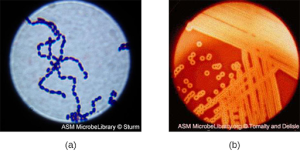
Staphylococcus is a second example of a gram-positive bacteria. The bacteria Staphylococcus comes from a Greek word for “bunches of grapes,” which describes their microscopic appearance in culture. Strains of Staphylococcus aureus cause a wide variety of infections in humans, including skin infections that produce boils, carbuncles, cellulitis, or impetigo. See Figure 3.2[7] for an image of Staphylococcus bacteria microscopically.
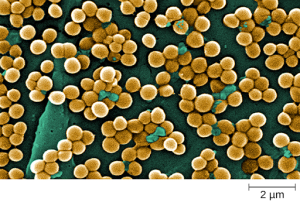
Many strains of Staphylococcus aureus have developed resistance to many antibiotics. Examples of antibiotic-resistant strains are methicillin-resistant Staphylococcus aureus (MRSA) and vancomycin-resistant Staphylococcus aureus (VRSA) . Antibiotic resistant strains are difficult to treat because they exhibit resistance to nearly all available antibiotics. Because they are difficult to treat with antibiotics, infections can be lethal. MRSA and VRSA are also very contagious, posing a serious threat in hospitals, nursing homes, dialysis facilities, and other places where there are large populations of elderly, bedridden, and/or immunocompromised clients.[8]
Sample Gram-Negative Infections
Gram-negative bacteria have a great ability to cause disease in humans and can infect almost all body systems, such as the digestive system, nervous system, urinary system, and bloodstream. A common gram-negative bacterium is Escherichia coli (E. coli). E. coli is a common cause of urinary tract infections due to its normal presence in the gastrointestinal tract that can contaminate the urinary tract and cause infection.
Other gram-negative bacteria can cause severe, sometimes life-threatening, disease. The genus Neisseria, for example, includes the bacteria Neisseria gonorrhoeae and causes the sexually transmitted infection gonorrhea, and Neisseria meningitidis causes bacterial meningitis. See Figure 3.3[9] for an image of Neisseria meningitides.
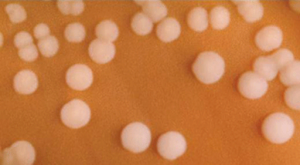
Broad-Spectrum vs. Narrow-Spectrum Antimicrobials
The spectrum of activity of an antibiotic is considered by providers when selecting an antibiotic to treat a client’s infection. A narrow-spectrum antimicrobial targets only specific subsets of bacterial pathogens.[10] For example, some narrow-spectrum drugs target gram-positive bacteria whereas others target gram-negative bacteria.
A broad-spectrum antimicrobial targets a wide variety of bacterial pathogens, including both gram-positive and gram-negative species. There are many reasons why a broad-spectrum antibiotic is prescribed. Broad-spectrum antibiotics may be prescribed while culture results are pending and then a narrow-spectrum antibiotic may be prescribed based on the culture and sensitivity results. Broad-spectrum antimicrobials are also used for polymicrobial infections (mixed infections with multiple bacterial species) or to prevent infections that may occur from surgery or invasive procedures. Additionally, broad-spectrum antimicrobials may be selected to treat an infection that has not responded to a narrow-spectrum antibiotic because of presumed antibiotic resistance.[11]
Effects on Microbiome and Potential Superinfection
A risk of using broad-spectrum antibiotics is they affect an individual’s microbiome. An individual’s microbiome consists of microbes that are both helpful and potentially harmful. Most are symbiotic (where both the human body and microbiota benefit), but some are pathogenic and cause disease. Broad-spectrum antibiotics can cause a disturbance in the balance between symbiotic and harmful microbiota, resulting in disease.[12]
For example, in the vagina, normal flora compete with opportunistic pathogens like Candida albicans. This competition prevents yeast infection by limiting the availability of nutrients and inhibiting the growth of Candida, keeping its population in check. However, when this balance is disrupted by an antibiotic, a yeast infection can occur.
Similar competitions occur between normal flora and potential pathogens in the gastrointestinal tract. Treatment with antibiotics can significantly deplete the normal flora of the gastrointestinal tract, providing an opportunity for pathogenic bacteria such as Clostridium difficile (C-diff) to cause diarrheal infection. Diarrhea caused by C-diff can be severe and potentially lethal. Interestingly, a recent strategy for treating recurrent C-diff infections focuses on restoring normal flora by transplanting fecal matter from a healthy donor with normal flora. See Figure 3.4[13] for an image of C-diff microscopically.
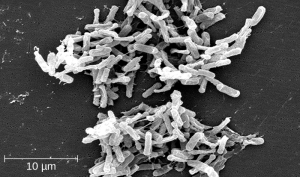
An infection caused by a disruption of the individual’s microbiome is also referred to as a superinfection (i.e., a secondary infection in a client having a preexisting infection). A superinfection develops when the antibiotic intended for the existing infection also kills the protective microbiome. An example of a severe superinfection is pseudomembranous colitis caused by C-diff, which can be fatal.[14]
Probiotics, such as lactobacillus, are commonly recommended for individuals taking antibiotics to restore normal flora into the gastrointestinal system and prevent diarrhea, yeast infections, and other superinfections.
Recap
- A broad-spectrum antibiotic treats gram-positive and gram-negative bacteria.
- A narrow-spectrum antibiotic treats either gram-positive or gram-negative bacteria.
- Broad-spectrum antibiotics impact the individual’s microbiome and can cause diarrhea and secondary infections like yeast infections (Candida) or C-diff. Probiotics may be prescribed to maintain an individual’s microbiome.
- If a client is started on an antibiotic that treats gram-positive infection, but the culture results identify a gram-negative organism, the medication will not improve the client’s status.
- At times, a broad-spectrum antibiotic may be prescribed prior to receiving the culture results due to the severity of the illness of the client. After the culture results are reported, the antibiotic therapy is then tailored to the client.
- It is the nurse’s responsibility to review culture results, ensure the results have been communicated to the prescribing provider, and request a different antibiotic is prescribed if indicated.
Antibacterial Actions
Bacteriostatic vs. Bactericidal
Antibiotics are selected by providers based on how and where the drug targets the bacteria. Antibiotics can be either bacteriostatic or bactericidal in how they target bacteria. Bacteriostatic drugs cause bacteria to stop reproducing but they may not kill the existing bacteria. In contrast, bactericidal drugs kill targeted bacteria.
The decision about whether to use a bacteriostatic or bactericidal drug often depends on the type of infection and the overall immune status of the client. In a healthy client with strong immune defenses, both bacteriostatic and bactericidal drugs can be effective. However, when a client is immunocompromised, a bactericidal drug is often required for successful treatment of infections. Additionally, life-threatening infections in any client, such as acute bacterial endocarditis, require bactericidal drugs to eliminate all offending bacteria.[15]
Mechanism of Action
Another consideration in antibiotic treatment is the drug’s mechanism of action. Each class of antibacterial drugs has a unique mechanism of action at the cellular level. For example, cephalosporins act on the integrity of the cell wall. In contrast, aminoglycosides impact ribosome function and inhibit protein synthesis, which stops the proliferation of cells.[16] See Figure 3.5[17] for a summary of how various antibiotics affect the cell wall, the plasma membrane, the ribosomes, the metabolic pathways, or DNA synthesis of bacteria.
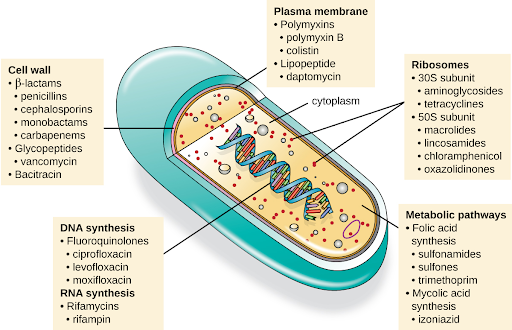
Antiviral Medications
Similar to antibacterial medications, antiviral antiviral drugs directly impact the reproduction of viruses. Unlike antimicrobials, antiviral medications do not kill the offending virus, but reduce replication and development of the virus. For example, oseltamivir (Tamiflu) is commonly prescribed to treat influenza.[18]
Antifungal Medications
Antifungal agents are medications that are used to treat fungal infections. Fungal infections commonly affect surface areas of the body, such as the toes, groin, nails, or mouth. Antifungal medications work by killing the cells of the fungus or inhibiting the reproduction of the cells. Many antifungals are applied topically to the affected area. For example, tinea pedis (athlete’s foot) is typically treated with a topical antifungal cream. Another example is the nystatin, commonly prescribed to treat oral thrush caused by Candida albicans. Nystatin may be prescribed as “swish and spit” as a topical oral treatment or “swish and swallow” for additional systemic effects.
Antibiotic Resistance
Although there is a wide availability of medications that are useful for treating infection, limited effectiveness of antibiotics is becoming an international problem. According to the Centers for Disease Control, each year in the United States, at least 2 million people are infected with an antibiotic-resistant infection, resulting in 23,000 deaths.[19]
Prevention Strategies
Most antimicrobial drugs are self-administered by clients at home. Unfortunately, many clients stop taking antimicrobials once their symptoms dissipate. For example, if a ten-day course of antibiotic treatment is prescribed, some clients only take the drug for five or six days and stop when they start feeling better, unaware of the negative consequences of not completing the full course of treatment. The problem with failing to complete a full course of antibiotic treatment is it not only fails to kill the target organisms to the expected levels but also facilitates the development of drug-resistant variant of the bacteria within the body. The overprescription of antimicrobials also contributes to antibiotic resistance. Clients may demand antibiotics from their health care provider for treatment of infections not caused by bacteria, such as viral upper respiratory infections (i.e., the common cold).
Nonadherence to completing a full course of treatment is often increased when the recommended course of treatment is long. For example, treatment for tuberculosis (TB) typically lasts from six months to a year. Additionally, the Centers for Disease Control and Prevention (CDC) estimates that about one third of the world’s population is infected with TB, most living in underdeveloped or underserved regions where antimicrobial drugs are available over the counter (OTC). The availability of OTC antibiotics may contribute further to the lack of completion of a full treatment regimen. As a direct result of these factors, multidrug-resistant strains of TB have become a significant problem.
One possible solution to preventing antibiotic resistance is directly observed therapy (DOT), which involves the supervised administration of medications to clients. Clients are either required to visit a health care facility to receive their medications, or health care professionals administer medication in clients’ homes or another designated location. DOT has been implemented in many countries for the treatment of TB and has been shown to be effective.
But is DOT a practical strategy for all antibiotics? Would clients taking penicillin, for example, be more or less likely to adhere to the full course of treatment if they had to travel to a health care facility to receive each dose? An additional consideration is who would pay for the increased cost associated with DOT?
Antibiotic resistance is a complex issue with no clear, easy solution. However, it is clear is that clients need extensive health teaching regarding the judicious and complete use of antibiotics to increase adherence and decrease the development of antibiotic resistance.[20]
Critical Thinking Activity 3.2
Reflecting on current health care challenges regarding the ongoing emergence of antimicrobial-resistant organisms, what actions could you take within your nursing practice to help prevent drug resistance?
Note: Answers to the Critical Thinking activities can be found in the “Answer Key” section at the end of the book.
Interactive Activity
“Antimicrobial Definitions” by E. Christman for Open RN is licensed under CC BY 4.0
- This work is a derivative of Microbiology by OpenStax licensed under CC BY 4.0. Access for free at https://openstax.org/books/microbiology/pages/1-introduction ↵
- Kristof, K., & Pongracz, J. (2016). Interpretation of blood microbiology results - function of the clinical microbiologist. The Journal of the International Federation of Clinical Chemistry and Laboratory Medicine, 27(2), 147-155. https://www.ncbi.nlm.nih.gov/pmc/articles/PMC4975230/ ↵
- Vorvick, L. (Ed.). (2019, February 7). Sensitivity analysis. https://medlineplus.gov/ency/article/003741.htm ↵
- This work is a derivative of Microbiology by OpenStax licensed under CC BY 4.0. Access for free at https://openstax.org/books/microbiology/pages/1-introduction ↵
- “OSC Microbio 04 04 Strep.jpg” by CNX OpenStax is licensed under CC BY 4.0. Access for free at https://openstax.org/books/microbiology/pages/4-4-gram-positive-bacteria ↵
- This work is a derivative of Microbiology by OpenStax licensed under CC BY 4.0. Access for free at https://openstax.org/books/microbiology/pages/1-introduction ↵
- This work is a derivative of “CDC-10046-MRSA.jpg” by Janice Haney Carr, Centers for Disease Control and Prevention and is licensed under CC0 ↵
- This work is a derivative of Microbiology by OpenStax licensed under CC BY 4.0. Access for free at https://openstax.org/books/microbiology/pages/1-introduction ↵
- “OSC Microbio 04 02 Neisseria.jpg” by CNX OpenStax is licensed under CC BY 4.0. Access for free at https://openstax.org/books/microbiology/pages/4-2-proteobacteria ↵
- This work is a derivative of Microbiology by OpenStax licensed under CC BY 4.0. Access for free at https://openstax.org/books/microbiology/pages/1-introduction ↵
- This work is a derivative of Microbiology by OpenStax licensed under CC BY 4.0. Access for free at https://openstax.org/books/microbiology/pages/1-introduction ↵
- Harvard T.H. Chan School of Public Health. (n.d.). The Microbiome. https://www.hsph.harvard.edu/nutritionsource/microbiome/ ↵
- This work is a derivative of “Clostridium difficile 01.jpg” by Lois D. Wiggs at Centers of Disease Control and Prevention and is licensed under CC0 ↵
- This work is a derivative of Microbiology by OpenStax licensed under CC BY 4.0. Access for free at https://openstax.org/books/microbiology/pages/1-introduction ↵
- This work is a derivative of Microbiology by OpenStax licensed under CC BY 4.0. Access for free at https://openstax.org/books/microbiology/pages/1-introduction ↵
- This work is a derivative of Microbiology by OpenStax licensed under CC BY 4.0. Access for free at https://openstax.org/books/microbiology/pages/1-introduction ↵
- “OSC Microbio 14 02 Modes.jpg” by CNX Openstax is licensed under CC BY 4.0. Access for free at https://openstax.org/books/microbiology/pages/14-3-mechanisms-of-antibacterial-drugs ↵
- This work is a derivative of Microbiology by OpenStax licensed under CC BY 4.0. Access for free at https://openstax.org/books/microbiology/pages/1-introduction ↵
- Centers for Disease Control and Prevention. (2022). About antimicrobial resistance. https://www.cdc.gov/drugresistance/about.html ↵
- This work is a derivative of Microbiology by OpenStax licensed under CC BY 4.0. Access for free at https://openstax.org/books/microbiology/pages/1-introduction ↵
An organism causing disease to its host.
A test performed to examine different body substances for the presence of bacteria or fungus.
A test performed in addition to a culture in order to select an effective antibiotic to treat the microorganism.
A characteristic of bacteria demonstrated lack of effective treatment by an antibiotic when a sensitivity analysis is performed.
A test used to quickly diagnose bacterial infection. Identification of bacteria as gram + or gram - assists the health care provider in selecting an appropriate antibiotic to treat the infection.
Gram-positive bacteria are classified by the color they turn after a chemical called gram stain is applied to them. Infections caused by Streptococcus and Staphylococcus bacteria are examples of gram-positive infections.
Gram-negative bacteria are classified by the color they turn after a chemical called gram stain is applied to them. Escherichia Coli (also known as E. Coli) is an example of a gram-negative infection.
An infection caused by Methicillin-resistant Staphylococcus aureus that is difficult to treat because it exhibits resistance to nearly all available antibiotics.
An infection caused by Vancomycin-resistant Staphylococcus aureus that is difficult to treat because it exhibits resistance to nearly all available antibiotics.
An antibiotic that targets only specific subsets of bacterial pathogens.
An antibiotic that targets a wide variety of bacterial pathogens, including both gram-positive and gram-negative species.
Clostridium difficile causes pseudomembranous colitis, a superinfection that can be caused by broad spectrum antibiotic therapy.
A secondary infection in a patient having a preexisting infection. C-diff and yeast infections as a result of antibiotic therapy are examples of superinfections.
Antimicrobial drugs that cause bacteria to stop reproducing but may not ultimately kill the bacteria.
Antimicrobial drugs that kill their target bacteria.
Medications used to treat viral infections. For example, Tamiflu is used to treat influenza.
Medications that are used to treat fungal infections. For example, nystatin is used to treat Candida Albicans, a fungal infection.

